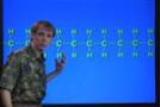Conceptual Physical Science
Chapter 19: Organic Compounds
Organic polymers are defined and then a special class of polymers, the addition polymers, are described. Duration: 4:55.
Condensation polymers are made from organic molecules that have two reactive functional groups on opposites sides of the molecule. The synthesis of nylon is demonstrated. Duration: 6:38.
John discusses the possibilities and responsibilities that we humans face. Thanks are also given to the many people involved in making this project possible. Duration: 7:20.
The programming for Conceptual Chemistry Alive! was originally created by Professor Michael Reese of Leeward Community College. He's the guy on the left in blue jeans during our final. Good chemistry to you! He stands next to Julia Meyers (in green) who designed the graphic user interface. The videos were directed and edited by Peter Elias who decided not get in front of the cameras for the final scene. He appears, however, in the textbook. Much directing and editing was also performed by Sharon Hopwood, who is the woman in gray on the far right. Irwin Yamamoto (closest to the screen) and Stacy Thomas (in white to the left and behind of John) were responsible for the filming of the Kai and Maile sequences. Camden Barruga, Ed Nartatez, Keli Sato, and Patrick Garcia (buried in the crowd) were the primary camera operators for the lecture sequences.
Mobile Link: http://bcove.me/iirz0f4c
Watch these additional videos to complete this tutorial.
Table of Videos
- Chapter 1: Patterns of Motion
- Chapter 2: Newton's Laws of Motion
- Chapter 3: Momentum and Energy
-
Chapter 4: Gravity, Projectiles, and Satellites
- 4.1 The Universal Law of Gravity
- 4.2 Gravity and Distance: The Inverse-Square Law
- 4.3 Weight and Weightlessness
- 4.4 Universal Gravitation
- 4.5 Projectile Motion
- 4.6 Fast-Moving Projectiles—Satellites
- 4.7 Circular Satellite Orbits
- 4.8 Elliptical Orbits
- 4.9 Escape Speed
-
Chapter 5: Fluid Mechanics
- 5.1 Density
- 5.2 Pressure
- 5.3 Buoyancy in a Liquid
- 5.4 Archimedes’ Principle
- 5.5 Pressure in a Gas
- 5.6 Atmospheric Pressure
- 5.7 Pascal’s Principle
- 5.8 Buoyancy in a Gas
- 5.9 Bernoulli’s Principle
-
Chapter 6: Thermal Energy
- 6.1 Temperature
- 6.2 Absolute Zero
- 6.3 Heat
- 6.4 Quantity of Heat
- 6.5 The Laws of Thermodynamics
- 6.6 Entropy
- 6.7 Specific Heat Capacity
- 6.8 Thermal Expansion
- 6.9 Expansion of Water
-
Chapter 7: Heat Transfer and Phase Change
- 7.1 Conduction
- 7.2 Convection
- 7.3 Radiation
- 7.4 Newton’s Law of Cooling
- 7.5 Climate Change and the Greenhouse Effect
- 7.6 Heat Transfer and Change of Phase
- 7.7 Boiling
- 7.8 Melting and Freezing
- 7.9 Energy and Change of Phase
-
Chapter 8: Electricity
- 8.1 Electric Force and Charge
- 8.2 Coulomb’s Law
- 8.3 Electric Field
- 8.4 Electric Potential
- 8.5 Voltage Sources
- 8.6 Electric Current
- 8.7 Electric Resistance
- 8.8 Ohm’s Law
- 8.9 Electric Circuits
- 8.10 Electric Power
-
Chapter 9: Magnetism
- 9.1 Magnetic Poles
- 9.2 Magnetic Fields
- 9.3 Magnetic Domains
- 9.4 Electric Currents and Magnetic Fields
- 9.5 Magnetic Forces on Moving Charges
- 9.6 Electromagnetic Induction
- 9.7 Generators and Alternating Current
- 9.8 Power Production
- 9.9 The Transformer—Boosting or Lowering Voltage
- 9.10 Field Induction
-
Chapter 10: Waves and Sound
- 10.1 Vibrations and Waves
- 10.2 Wave Motion
- 10.3 Transverse and Longitudinal Waves
- 10.4 Sound Waves
- 10.5 Reflection and Refraction of Sound
- 10.6 Forced Vibrations and Resonance
- 10.7 Interference
- 10.8 Doppler Effect
- 10.9 Bow Waves and the Sonic Boom
- 10.10 Musical Sounds
-
Chapter 11: Light
- 11.1 Electromagnetic Spectrum
- 11.2 Transparent and Opaque Materials
- 11.3 Reflection
- 11.4 Refraction
- 11.5 Color
- 11.6 Dispersion
- 11.7 Polarization
-
Chapter 12: Atoms and the Periodic Table
- 12.1 Atoms Are Ancient and Empty
- 12.2 The Elements
- 12.3 Protons and Neutrons
- 12.4 The Periodic Table
- 12.5 Physical and Conceptual Models
- 12.6 Identifying Atoms Using the Spectroscope
- 12.7 The Quantum Hypothesis
- 12.8 Electron Waves
- 12.9 The Shell Model
-
Chapter 13: The Atomic Nucleus
- 13.1 Radioactivity
- 13.2 The Strong Nuclear Force
- 13.3 Half-Life and Transmutation
- 13.4 Radiometric Dating
- 13.5 Nuclear Fission
- 13.6 Mass-Energy Equivalence
- 13.7 Nuclear Fusion
-
Chapter 14: Elements of Chemistry
- 14.1 Chemistry: The Central Science
- 14.2 The Submicroscopic World
- 14.3 Physical and Chemical Properties
- 14.4 Determining Physical and Chemical Changes
- 14.5 Elements to Compounds
- 14.6 Naming Compounds
- 14.7 The Advent of Nanotechnology
-
Chapter 15: Bonds and Molecular Attractions
- 15.1 Electron-Dot Structures
- 15.2 The Formation of Ions
- 15.3 Ionic Bonds
- 15.4 Metallic Bonds
- 15.5 Covalent Bonds
- 15.6 Polar Covalent Bonds
- 15.7 Molecular Polarity
- 15.8 Molecular Attractions
-
Chapter 16: Mixtures
- 16.1 Most Materials Are Mixtures
- 16.2 The Chemist's Classification of Matter
- 16.3 Solutions
- 16.4 Solubility
- 16.5 Soaps, Detergents, and Hard Water
- 16.6 Purifying the Water We Drink
- 16.7 Wastewater Treatment
-
Chapter 17: How Chemicals React
- 17.1 Chemical Equations
- 17.2 Counting Atoms and Molecules by Mass
- 17.3 Reaction Rates
- 17.4 Catalysts
- 17.5 Energy and Chemical Reactions
- 17.6 Chemical Reactions Are Driven by Entropy
-
Chapter 18: Acids/Bases and Redox
- 18.1 Acids Donate Protons; Bases Accept Them
- 18.2 Relative Strengths of Acids and Bases
- 18.3 Acidic, Basic, and Neutral Solutions
- 18.4 Acidic Rain and Basic Oceans
- 18.5 Losing and Gaining Electrons
- 18.6 Harnessing the Energy of Flowing Electrons
- 18.7 Electrolysis
- 18.8 Corrosion and Combustion
-
Chapter 19: Organic Compounds
- 19.1 Hydrocarbons
- 19.2 Unsaturated Hydrocarbons
- 19.3 Functional Groups
- 19.4 Alcohols, Phenols, and Ethers
- 19.5 Amines and Alkaloids
- 19.6 Carbonyl Compounds
- 19.7 Polymers
-
Chapter 20: Rocks and Minerals
- 20.1 The Geosphere is Made Up of Rocks and Minerals
- 20.2 Minerals
- 20.3 Mineral Properties
- 20.4 Classification of Rock-Forming Minerals
- 20.5 The Formation of Minerals
- 20.6 Rock Types
- 20.7 Igneous Rocks
- 20.8 Sedimentary Rocks
- 20.9 Metamorphic Rocks
- 20.10 The Rock Cycle
-
Chapter 21: Plate Tectonics
- 21.1 Seismic Waves
- 21.2 Earth’s Internal Layers
- 21.3 Continental Drift—An Idea Before its Time
- 21.4 Acceptance of Continental Drift
- 21.5 The Theory of Plate Tectonics
- 21.6 Continental Evidence for Plate Tectonics
- 21.7 The Theory That Explains the Geosphere
-
Chapter 22: Shaping Earth's Surface
- 22.1 The Hydrologic Cycle
- 22.2 Groundwater
- 22.3 The Work of Groundwater
- 22.4 Surface Water and Drainage Systems
- 22.5 The Work of Surface Water
- 22.6 Glaciers and Glaciation
- 22.7 The Work of Glaciers
- 22.8 The Work of Air
-
Chapter 23: Geologic Time
- 23.1 The Rock Record—Relative Dating
- 23.2 Radiometric Dating
- 23.3 Geologic Time
- 23.4 Precambrian Time (4500 to 543 Million Years Ago)
- 23.5 The Paleozoic Era (543 to 248 Million Years Ago)
- 23.6 The Mesozoic Era (248 to 65 Million Years Ago)
- 23.7 The Cenozoic Era (65 Million Years to the Present)
- 23.8 Earth History in a Capsule
-
Chapter 24: The Oceans and Atmosphere
- 24.1 Earth’s Atmosphere and Oceans
- 24.2 Components of Earth’s Oceans
- 24.3 Ocean Waves, Tides, and Shorelines
- 24.4 Components of Earth’s Atmosphere
- 24.5 Solar Energy
- 24.6 Driving Forces of Air Motion
- 24.7 Global Circulation Patterns
-
Chapter 25: Driving Forces of Weather
- 25.1 Atmospheric Moisture
- 25.2 Weather Variables
- 25.3 Cloud Development
- 25.4 Air Masses, Fronts, and Storms
- 25.5 Violent Weather
- 25.6 The Weather, Topic of Conversation
-
Chapter 26: The Solar System
- 26.1 The Solar System and its Formation
- 26.2 The Sun and Seasons
- 26.3 The Inner Planets
- 26.4 The Outer Planets
- 26.5 Earth's Moon
- 26.6 Failed Planet Formation
-
Chapter 27: Stars and Galaxies
- 27.1 Observing the Night Sky
- 27.2 The Brightness and Color of Stars
- 27.3 The Hertzsprung-Russell Diagram
- 27.4 The Life Cycles of Stars
- 27.5 Black Holes
- 27.6 Galaxies
-
Chapter 28: Space and Time
- 28.1 Looking Back in Time
- 28.2 Cosmic Inflation
- 28.3 and 28.4 Relativity
- 28.5 Dark Matter
- 28.6 Dark Energy
- 28.7 The Fate of the Universe
-
Review
- Review 1
- Review 2
- Review 3
- Review 4
- Review 5



